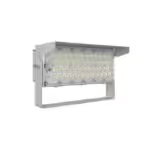

Key Features
1. Power Consumption (Wattage)
- Range: Typically between 10W to 2000W, depending on the application.
- Description: The power rating indicates the electrical power the flood light consumes. Lower wattages (e.g., 10-50W) are suitable for residential or small area lighting, while higher wattages (e.g., 200-2000W) are used for industrial, sports, or large outdoor areas.
2. Luminous Flux (Lumen Output)
- Range: Usually ranges from 800 lumens (for small, low-wattage lights) to over 200,000 lumens (for high-power lights).
- Description: Lumen output measures the total amount of visible light emitted by the flood light. Higher lumen values indicate brighter lights, suitable for larger or more demanding applications.
3. Color Temperature (Kelvin)
- Range: Typically from 2700K (warm white) to 6500K (cool daylight).
- Description: Color temperature affects the color and tone of the light emitted. Warm white (2700-3000K) creates a soft, cozy atmosphere, while cool white or daylight (5000-6500K) provides a bright, clear light ideal for security or task lighting.
4. Beam Angle
- Range: Commonly between 60° to 120°, but can be narrower or wider depending on the design.
- Description: The beam angle determines the spread of light. A narrower angle (e.g., 30°) focuses light on a specific area, while a wider angle (e.g., 120°) covers a larger area.
5. Color Rendering Index (CRI)
- Range: Typically 70-90 or higher.
- Description: CRI measures the ability of the light to reveal the true colors of objects compared to natural light. A CRI of 80 or above is generally considered good for most applications, with higher CRIs preferred for settings requiring accurate color representation.
6. IP Rating (Ingress Protection)
- Range: Commonly IP65, IP66, IP67, or IP68.
- Description: The IP rating indicates the level of protection against dust and water. For outdoor use, an IP65 or higher rating is recommended to ensure durability in various weather conditions. IP67 or IP68 ratings offer protection against immersion in water, making them ideal for more extreme environments.
7. Voltage
- Range: Typically 110-240V AC for standard flood lights; 12V or 24V DC for low-voltage models.
- Description: The operating voltage should match the power supply available at the installation site. Some flood lights support a wide voltage range, making them versatile for different regions.
8. Material and Finish
- Materials: Aluminum alloy and die cast for the body (for durability and heat dissipation), polycarbonate or tempered glass for the lens.
- Description: The construction material affects the durability, heat management, and impact resistance of the flood light. Powder-coated finishes are often used for corrosion resistance in outdoor environments.
9. Mounting Options
- Types: Wall mount, ground stake, pole mount, adjustable brackets, etc.
- Description: Flood lights come with various mounting options to suit different installation needs. Adjustable mounting brackets allow the light to be directed precisely where needed.
10. Operating Temperature
- Range: Typically -20°C to +50°C (-4°F to +122°F) or broader.
- Description: This specification indicates the range of ambient temperatures within which the flood light can operate safely and effectively. Lights with a wider range are suitable for extreme weather conditions.
11. Dimming and Control Options
- Types: Manual dimming, remote control, smart controls (Wi-Fi, Bluetooth), photocell sensors, motion sensors, and timers.
- Description: Dimmable flood lights offer flexibility in adjusting brightness levels. Advanced models may offer smart controls that integrate with home automation systems or provide remote operation.
12. Lifespan
- Range: Typically 30,000 to 100,000 hours for LED flood lights.
- Description: Indicates the expected operational life of the light. Longer lifespans reduce maintenance and replacement costs.
13. Efficiency (Lumens per Watt)
- Range: Usually between 80 to 160 lm/W or higher.
- Description: Efficiency measures how well the flood light converts electrical energy into visible light. Higher lumens per watt values mean more efficient lights.
14. Certifications and Compliance
- Types: CE, RoHS, UL, DLC, ETL, FCC, etc.
- Description: Certifications ensure that the flood light meets specific safety, quality, and energy efficiency standards required by various regions or applications.
15. Size and Weight
- Range: Varies based on design and power; from compact models (around 5-10 lbs) to larger industrial lights (50 lbs or more).
- Description: The physical dimensions and weight of the flood light affect installation requirements and suitability for different mounting types.
16. Surge Protection
- Range: Typically 2KV to 10KV or more.
- Description: Flood lights with built-in surge protection can withstand electrical surges caused by lightning or power fluctuations, protecting the light and ensuring longevity.





